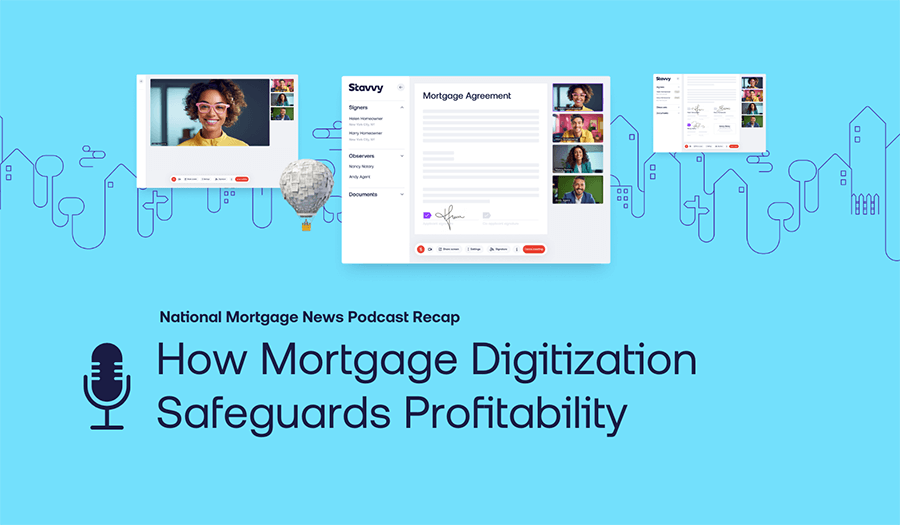“Mortgage industry” and “change leader” are not often found in the same sentence.
One plausible explanation is that mortgage professionals have relied on paper, pens, and postage since the mortgage industry came into existence in the 1930s.
Today, however, the office supplies needed to process and close a mortgage are evolving.
Paper is becoming obsolete as digital mortgages gain traction as the preferred option for lenders, title agents, and their mutual customers.
Simon Moir, Vice President and Segment Leader at Wolters Kluwer Compliance Solutions, agrees that paper processes have been in place for so long that adopting a new way of doing things has been slow to catch on. He sees hesitation to adopt eNotes, a vital component of digital mortgage closings, and shares how the mortgage industry can get more comfortable embracing change.
“Change is difficult. It's not just about changing technologies; it's changing operations to speed up and drive better business processes. Adoption seems to fluctuate based on the times. The number one conversation I have with lenders, or anyone who's going to be involved in the digital closing, and the assets that get created from that, is they must have an ecosystem that is 100% on board to control the technology in a centralized way. ”
- Simon Moir
Simon joined Jeremy Potter and Shane Hartzler on Stavvy’s Finside Chats® podcast to discuss digitizing the residential mortgage process, including the addition and adoption of eNotes, and why there isn’t full digital mortgage adoption in the industry yet.
On this episode of Finside Chats®, you’ll learn about:
- Misconceptions about eNote and its role in mortgage digital transformation
- Why it’s crucial to opt for a digital-first mortgage approach
- The perfect time to adopt digital mortgage processes
- Why stakeholder education is key to digital mortgage success
Listen now: Mortgage Digital Transformation: It’s Time for eClosing and eNote
eNotes are the last milestone in mortgage digital transformation, yet myths sour adoption
Lenders in a rising rate environment tend to focus on costs and operational efficiencies.
As a mortgage technology provider, the obvious next step is to consider how eClosings and eNotes support lower transaction costs and increased productivity—but do lenders agree?
Simon shares that misconceptions about eNote acceptance and whether or not it is mutually exclusive with remote online notarization (RON) legislation have led to confusion and low adoption rates in the mortgage industry.
“Those myths either make me laugh or make me cry, sometimes both at the same time. That’s the thing, right? The eNote is legally allowed through regulations. Across the nation, legally, nothing is stopping an electronic promissory note for a mortgage. It doesn’t matter what state or type of loan product,” said Simon.
But this myth deepens when industry professionals lump eNote and RON acceptance together.
“You might have ecosystem folks, investors, or custodians that might not have the capability to accept [an eNote], but it certainly is accepted from a legal perspective. One of the biggest myths that just kills me is the connection between RON and eNote. There are definitely restrictions, although far less now than when we started four to five years ago, and that’s regarding RON. I’ve certainly had people come to me and go, ‘sorry; I can’t talk to you about eNote; we operate in California, and they’re not legal in California.’ But they can. I don’t think there’s purposeful misinformation; I think vendors are promoting what they can offer to the market today, not necessarily what is possible, and not necessarily what the customer and lender need.”
The promissory note is the most important document to be signed at a mortgage closing. Having it on paper has been the status quo for decades. However, it requires stakeholders to ship paper, adding unnecessary time, cost, and risk to the process.
By streamlining and digitizing promissory note delivery to investors via an eNote, lenders can create speedier closings, better quality control, and greater transparency. An eNote also cuts the costs associated with storing, shipping, and purchasing paper while delivering mortgage notes to the secondary market quickly and securely.
Although eNote adoption has yet to take hold of most loans, Simon, Jeremy, and Shane agree the future is promising now that the industry is trending toward eClosings and RON as the new standard.
Advice for lenders on mortgage digital transformation
Executing a digital-first approach to mortgage lending takes a lot of work for loan providers. However, Simon suggests that they must be committed to going digital to find success.
“It’s not effective to sometimes choose paper and sometimes choose digital,” said Simon. “When I talk to companies of all shapes and sizes at varying levels of sophistication around their technology, I tell them to stay vigilant in making paper be the exception and not the rule for eClosings. That's where you get effective and really see the adoption curve increase.”
Contending with economic cycles and successfully timing mortgage digital transformation
The housing crisis of 2008, COVID-19 social distancing restrictions, and rising rate environments in 2022 are all seemingly appropriate economic instances to drive mortgage eClosings.
Yet, adoption still lags—why?
Simon shares that, despite hopeful circumstances for mortgage digital transformation, organizations were focused solely on operations in the moment versus future-proofing or planning for the next chapter of their business.
“Everyone thought these certain economic cycles were going to be the right time to move to digital. I don’t think that happened primarily because people were scrambling to operate at a scale they had never experienced before,” said Simon.
“There was no preparation or plan of attack other than needing to close loans—and fast. What we saw is that those people who had already invested in digital technologies had the competitive edge because they dedicated time upfront to figure it out, so they were prepared. Those technologies are not only good at organizing information, data, and workflows but also wringing costs out of the process. As a result, it was easier for them to scale their operations.”
Educating stakeholders on the benefits of mortgage digital transformation
The digital transformation of any industry is often slow because there needs to be a cohesive vision to drive change.
This is why Shane believes it’s vital for the industry to continue educating and driving digital-first strategy conversations with partners.
He shares that adoption has been most successful when lenders are constantly educating. Industry professionals are talking to their realtor partners, homeowners, loan officers, closing specialists, and everyone involved with settlement and escrow about the possibilities of eClosing, eNote, and digital transformation to improve the entire mortgage ecosystem.
“You can't assume everyone will be on board. Not everyone is always going to be aligned,” said Shane. “What you don't want to do is have that one party that's not aligned disrupt the process because they are only comfortable with the old way of doing it. That’s why education is critical.”
Defaulting to digital is vital to mortgage digital transformation in the industry
Every day, demand for a digital-first approach to mortgage lending and closing grows. However, demand and adoption are not mutually exclusive.
Looking outside of the mortgage industry for examples of adoption, you’ll see that the industries and companies that have succeeded with digital transformation and widespread technology adoption are the ones that commit to being a digital organization from the start.
Diving head-first into digital can be scary. However, tackling digital closings at scale, for both purchases and refinances, can make lenders feel more comfortable with the process faster. Fortunately for those embracing the paperless revolution, there is no shortage of great digital mortgage technology partners to help guide the process, educate, and support successful onboarding and implementation.
Adoption is never immediate, no matter the technology or industry. Driving change that creates a chain reaction requires this industry to keep its foot on the gas by prioritizing digital-first conversations, providing education, and communicating success within the mortgage ecosystem.
Learn more about how the  is taking real estate beyond documents.
is taking real estate beyond documents.



![[Webinar Recap] Advancing Your Digital Default Servicing Strategy](https://blog.stavvy.com/hubfs/advancing-your-digital-default-servicing-strategy-blog-recap.png)